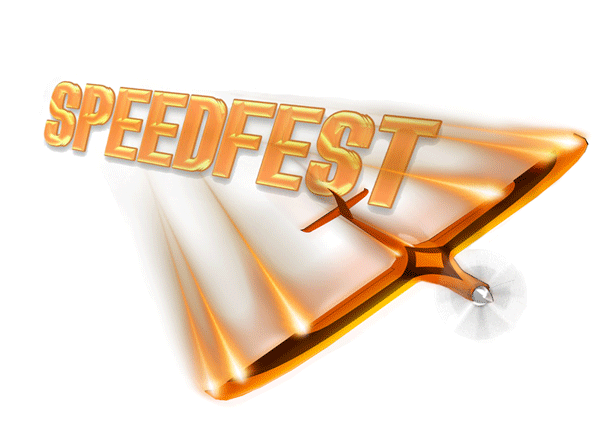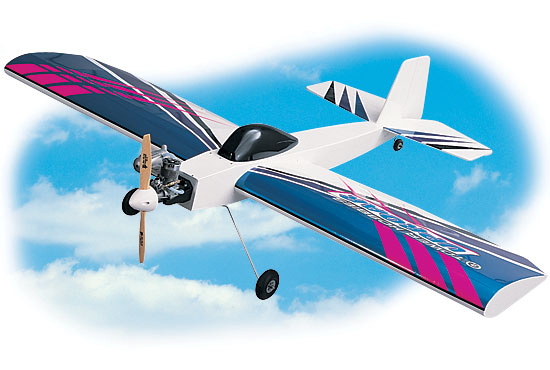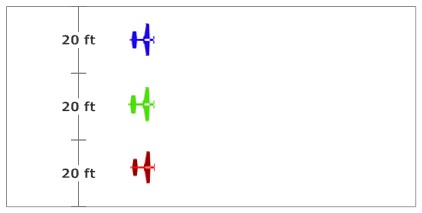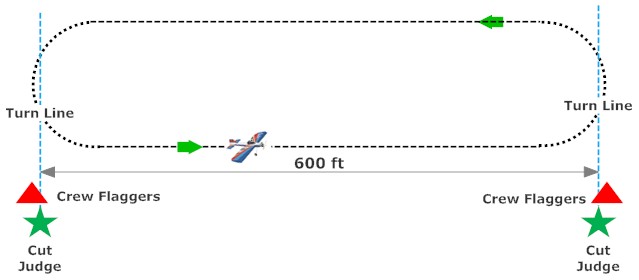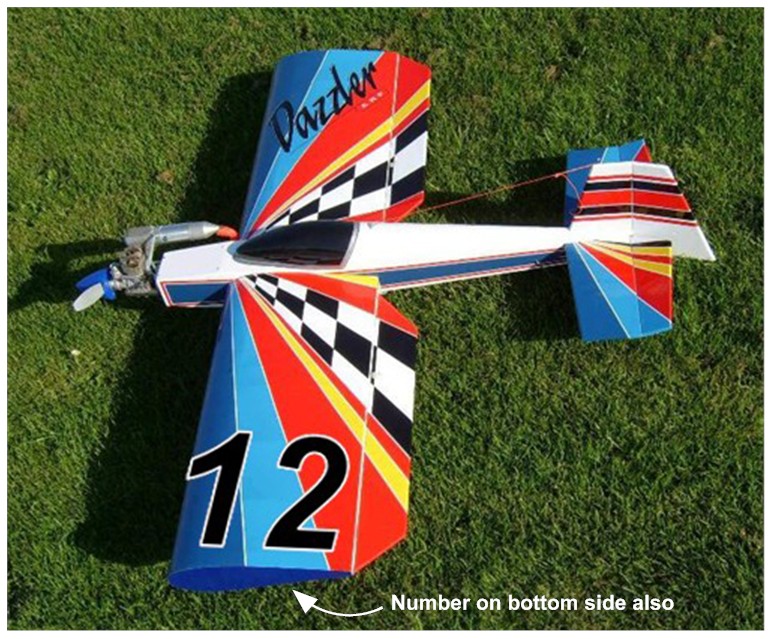April
28-30, 2017
Hosted By:

INDIA Class
Speedfest
is an exciting, high-speed aircraft design competition which is
intended to foster enthusiasm for aviation, and unmanned aircraft
design. There are two flight classes: Alpha Class is the Advanced class which
is for collegiate-level teams. India Class is the Invitational class.
It is open to high-school level teams and teams with similar
skill level, on an invitational
basis. The
top 3 teams in each class will be recognized with awards. The
winners of each class will be awarded the Speedfest
Cup.
Suggestions for India
Class Teams and Teachers
Contents:
Mission
Requirements and Design Constraints
Flight Procedures and Scoring
Safety Requirements
General Aircraft Requirements
Contest Day Information
Eligibility
Entry Form Format
Deadlines
Contest Site
Mission Requirements
- Complete
as many laps as possible in 2 minutes on a 600
ft. course
Design Constraints
- Teams
will be provided with a Tower Hobbies Uproar 40 kit: an O.S. 46AX II ABL w/Muffler
engine, and a voltage monitor.
Teams may
obtain the
remaining
items needed to build and fly the aircraft which are listed in the kit
manual. (Assuming a team is starting with no equipment whatsoever, this
should cost no more than approximately $500. Assistance with
material costs are available from contest directors in case of
hardship) Teams
may compete with multiple airplanes, however only a single kit will be
provided to each team. Teams
must build their airplanes and may
NOT
use a pre-built or ARF airframe or major component such as fuselage or
wing. Wings, tails, and fuselage must be built-up
wood
construction. (The same method used for the kit).
- Teams may build the airplane in the STOCK configuration (see
details below) and be eligible for all India-Class awards as well as
new STOCK
category awards. Alternatively, teams may make any airframe
redesign, modifications, and substitutions to improve performance,
subject to restrictions as follows:
Wing
- Wing span measured at the widest points of the wing
planform may be no more than 52 inches
- Wing
thickness measured at the max thickness location
everywhere along
the span except the last 2 inches near the wing tips, must be no less
than 1-3/16
inches.
- Wing chord must be constant along the span except for the
last 2 inches near the wing tips.
- Wing planform (Top View) wing area may be no less
than 500
sq. in. Wing area will be calculated by multiplying wing span
by average wing chord.
Empennage
- Wing leading edge to any part of the tail surfaces must be at least 22.5
inches.)
- Tail may be any configuration, however horizontal (107 in2) and vertical (43 in2) tail effective exposed area
must be
same as STOCK. Elevator effective area must be at least 15%, and
rudder effective area 30%. If a tail configuration is not stock,
the team must demonstrate to the judges in writing and a simple
sketch, compliance with the tail, elevator, and rudder area
restrictions. This should be sent to the Speedfest email address as early as possible for approval.
General
- All
changes to the Uproar design, such as adding or subtracting
material, changing dimensions, and/or use of materials or
components not provided in the kit are allowed (subject to the design
constraints.)
However the structural
integrity of the aircraft must not be compromised, and the airplane
must pass the
safety inspection.
- Longitudinal Center of Gravity (CG) must be no farther aft than the
1/4 chord point of the wing root measured from the leading edge.
- Fuel:
The fuel will be contest-supplied, Cool Power 15% or
equivalent.
- Commercially
available propeller for internal combustion engines. Tips
must be painted white for visibility, and balanced.
(See General Aircraft Requirements)
- Teams must use a 5-cell
NiMH or NiCD receiver pack with an external switch and the voltage monitor
mounted on the top of the fuselage so it is always visible while the
plane is on the ground. The monitor must be set to the 6V
position.
- ROG
(Rise off ground) only. No launch assist of any type including "push". Nothing may be
intentionally dropped from the plane.
Teams may use a
flight crew member to hold the airplane at the tail prior to
release if they desire. The runway is a smooth geotextile
material, and is 60 ft wide by 600 ft long.
- STOCK Category: No deviations, modifications, omissions, or
additions to the kit plans are allowed if a team wishes to compete for
STOCK awards. Stock canopy and landing gear must be used as well. Main wheels must be Dubro 2.5 inch and tail wheel must be Dubro 1 inch or equivalent. Fuel tank must be 4 to 8 oz.
- Design
objectives have been created to be as straightforward as possible to
minimize the chances of ambiguity, or multiple
interpretations.
If however, there are questions about the contest, please
email the address found below in the Entry
Form Format section.
Flight
Procedures and Scoring
- Aircraft
will be flown in up to 4-plane heats.
- Planes
will be launched from a line abreast configuration, staggered
in time. A sample 3-plane heat is shown below.
- Flight crew will hold the airplanes from behind.
The Starter
will call
"ready" at which time the pilots may apply full throttle. The
Starter will point to each team, at approximately 1
second intervals indicating they may release their aircraft.
Each plane will take off in sequence
starting
from the outermost plane. Since the course entry is
shifted to the east from the runway for safety, the staggered start
eliminates any advantage of
an airplane in an inner starting lane.
- Timer starts when the Starters flag first drops.
- Laps are performed in left-handed ovals as indicated in the
figure below. Planes do not need to fly around a flag, they
just must pass a turn line in space. If
wind conditiions force takeoff to the north, planes will take off in
the same order, however the first turn will be to the right.
- Each
team will provide two flight crew members to serve as turn
indicators, and will stand next to the Cut Judges. When a
plane crosses the turn line, they will signal their caller by
raising
a flag. Crew flaggers must not raise a flag prior to the
airplane
crossing the turn line, or it will be considered a "cut" resulting in a
DQ. This is the most common reason for a DQ.
- Cut Judges will use
a
sighting guide to
determine when a plane has passed a turn line, and if a flag has been
raised early, or if a plane has "cut" the turn. If a cut
occurs,
the judge will identify the number of the offending team, and
indicate a disqualification (DQ) for that
flight attempt by raising a flag. If a plane is DQ'ed, the
pilot should land as
soon as possible. A DQ results in no points being awarded for
that heat, which will affect a team's overall score.
- Teams
must bring their own "flags." The "flags" must be a board
such as plascore or foam posterboard with the team number on both
sides. The numbers must be at least 20
inches tall. Flaggers will hold the signs with
both hands
and promptly raise the sign over thier head as their plane crosses the
line. It is important that the signs are as legible as
possible
from 300 ft. away. The signs will be used by the caller to
call
turns, as well as by the judges to award a point.
Score:
Scoring is
based on distance traveled (flags) within two minutes,
on a course with 2 turn markers spaced 600ft. apart. One
point is
awarded for each turn line reached (including the first).
Awards:
The
Speedfest organizers will present 13 India Class awards in the following
7 categories. Criteria shown in parentheses:
- Overall Score Champion (Sum of all points scored by a team
for the entire day)
- Speedfest
Cup awards (Based on the best single
score for the day)
- 1st
Place
- 2nd
Place
- 3rd
Place
- 1st Place STOCK (airplane must be completely built to Stock plans)
- 2nd Place STOCK (airplane must be completely built to Stock plans)
- 3rd Place STOCK (airplane must be completely built to Stock plans)
- India
Class Promotional Video Award
(A
video is required of all India Class teams. Follow link for
details.)
- Best Airplane Build (Quality of overall build,
attention to detail, innovative design features)
- Best Airplane Graphics (Design and quality of
covering and / or paint scheme)
- Best Helmet (Helmet graphics)
- Team Spirit (Judged on sportsmanship, spirit,
integrity)
Tiebreakers:
- In
case of a tie for Speedfest Cup awards, best Overall Score will be used as the tiebreaker..
- In
case of a tie for the Overall
Score award, the the highest Promotional
Video score will decide placement.
Safety Requirements
Safety
must be the number one priority of all contest participants. The
Speedfest organizers have gone to great lengths to keep the event safe
for participants and spectators. Please carefully note the
following:
- Contestants are expected to conduct themselves, and operate
their aircraft in accordance to the AMA Safety Code. (the following
link contains all AMA documents including the Safety Code: http://www.modelaircraft.org/documents.aspx)
- Every
person beyond the spectator line (including officials), must
wear a helmet approved by OSHA, DOT, ANSI, SNELL,NOCSAE or other
recognized organization that certifies safety equipment.
There is
a very wide variety of helmets that meet these criteria including;
skateboarding helmets, bicycle helmets,
construction hard-hats,
etc.
- Any flight
crew member involved with starting the aircraft engine at any time
(flightline or
pits), or holding the airplane, must wear official safety glasses and
gloves (level-5 cut-resistant gloves are strongly
recommended
example).
- Teams
must make sure that people are standing clear of the plane of the
propeller in case of a blade failure. The safest
location is
behind the propeller. All individuals must be behind the
plane of
the propeller when running up the engine. Only the starter
should
be in front, however the throttle should not be advanced until the
starter is in a safe location.
- Flight
Crew: Required minimum flight crew is 4 members
(Pilot, Caller, and 2 Flagmen). Beyond that, the number and
makeup
of the flight crew is at the discretion of each team, however it may
consist of a maximum of 7 team members. Functions of flight crew
members may be combined if desired. All must verify current
AMA
membership at the event. Typical flight crew functions
include:
- Caller:
Stands by the pilot to call turns.
- Crew Flagmen:
Minimum
of two. Stand near turn marker judges to indicate turn line
passage
- Recovery:
(Optional)
Only flight crew and contest officials may
go recover aircraft
- Starter/Timer:
(Optional) Teams may have a member assist with
starting the engine on the
runway, and runup prior to start. The person may also serve
as a timer or additional flagman.
- When a team
is called for a flight, only flight crew may enter the field
beyond the spectator area.
- All aircraft
to be flown must go through an airworthiness inspection outlined below.
- Teams must conduct test flights only
at an AMA-sanctioned airfield. There are sanctioned clubs
throughout the state. The AMA mentor can assist with
access
to a sanctioned flying site. Additionally, teams may go to
the AMA club locator site to find one.
- For
teams not familiar with AMA contest airworthiness inspections, it is
recommended that an experienced RC pilot or AMA Contest Director assist
the team with an airworthiness inspection prior to travelling to the
Speedfest in order to reduce the chances of a delay requiring repairs
or modifications.
- All team
members must be committed to the AMA safety code
when designing, building, and flying, unmanned aircraft. AMA
has
a free youth membership for people 19 and younger, and a
low-cost
trial 90-day membership if necessary. AMA Membership Link Teams
are encouraged to apply to AMA early, for a Model Aviation Student Club
Charter. One of the benefits is free AMA memberships: MASC
- Engines or
motors must not be started in the teams pit area. There will
be designated areas for engine runup and testing.
- Proof of flight must be demonstrated prior to 9 AM on
contest day, or the team will not be allowed to compete.
Pilots
- Speedfest is
not an event
appropriate for novice pilots. Teams should use
experienced
pilots
with a record of safety.
- Contest organizers will provide a pilot upon request.
Teams may not however request a specific pilot.
- Pilot instructions:
- Safety must the primary responsibility of every pilot.
- If
there is some aspect of the airplane that the pilot deems unsafe, he
must ensure the team takes corrective action before flight.
- Pilots
must follow the instructions of the safety officer during flight.
If
instructed to abort, or even sacrifice the airplane for safety, the
pilot must do so immediately without question.
- Pilots
must never allow the airplane to cross a line defined by the West edge
of the runway. If the line is crossed, power must be cut
immediately, and a turn made away from the spectators.
- Pilots
will be instructed how far to the east to fly patterns in order to
maintain safe distances from the spectators. India class uses
a
275 ft. setback from the spectator line.
General
Aircraft Requirements
Landing
Gear
No
part of the aircraft
may be jettisoned or fall off,
including, landing gear which must stay with the aircraft at all
times. For example, no “dollies” or sleds.
Propeller
Metal
propellers are prohibited. Only propellers designed for
internal combustion engines are allowed. Teams
must paint the tips of their propellers (approximately 0.5 inches) on
both
sides, white. This is to reduce
chances
of injury. (Teams should balance their propellers after they are
painted.)
Engine
Mounting
The
engine should be securely attached to the mount, and the mount to the
airframe. Due to vibration, mounting bolts must use nylock
nuts,
or blue Loctite.
Radio
Gear:
Only
2.4 GHz spread
spectrum radios will be allowed. A standard radio range check
should be conducted at the Speedfest airfield by the mentor or teacher,
who will then verify pass, to the technical inspection judges.
The
receiver
battery must be a 5-cell (6v) NiCD or NiMH pack and have an
external
switch. Teams must
use a voltage monitor mounted
permanently to the TOP of the plane so that it may be seen at
all times when the plane is on the ground. The monitor may be
plugged into an open channel on the receiver, or connected to
a "Y" at a point after the switch. The
monitor must be ON when the required receiver switch is ON.
The Voltwatch
must be set to the 6V position.
Covering:
Teams are
encouranged to cover the wing with contrasting colors on the top and
bottom of the wing. With the darker color on the bottom of the
wing. This will assist the pilot in quickly determining the
airplane's orientation.
Team
Numbering
Each
team will mark their airplane with their team number which will be
assigned by the Speedfest organizers. Each airplane must be
numbered on the port wing (left side as viewed from sitting in the
cockpit) top AND bottom of the wing. Numbers must be 10
inches
tall, and at least 1 inch thick. The bottom of the number
should
face the wingtip so that the judges can easily read the team number
during turns. Teams may choose the number colors, but the
color
chosen should be the highest contrast possible with the background
color of the wing so that it is easy to see from a distance.
Teams should take care to choose fonts, or number styles so
that
it is difficult to mistake a number when it is upside down (such as 6
and 9) or from other numbers (1 and 7, 4 and 9). The
picture below illustrates a properly numbered airplane:
Preflight
Airworthiness Inspection of Aircraft
Prior
to
competition, all aircraft shall undergo a safety inspection.
Safety inspections will be conducted on a first come, first
served basis. Teams are encouraged to go through safety inspections on
the Friday afternoon of Speedfest so as to not miss any flight
opportunities.
The overall quality of construction must be considered safe and
airworthy.
Safety inspectors will be checking the following:
- Push/pull
rods or cables and control horns, shall be installed in
such a way that they will not become disconnected in flight. Clevises
must have a "keeper mechanism." Adjustable control linkages that use
set screws or friction are NOT acceptable.
- Pushrods
shall have only one threaded end that is free to turn.
- Control
surfaces shall be firm on the hinge line without excessive play.
- Servos shall
be mounted securely with little play.
- Any servo extensions used must have connections secured
with a servo lead lock (electrical tape or shrink wrap is permitted)
- All screws
holding the engine to the mount and the mount to the firewall shall be
in place and secure using nyloc nuts or Loctite.
- Spinner or
prop nut used to secure propeller.
- Prop tips painted white last 0.5 inches of span.
- The radio receiver and battery pack shall be secure, and
surrounded
by soft foam rubber or other vibration-dampening material and
adequately protected against contamination by engine exhaust, raw fuel,
or fuel residue.
- Receiver battery check: 5-cell NiCD or NiMH, external
switch, and visible voltage monitor when switch ON et to 6V setting.
- Check that transmitter used has a fail-safe set to throttle cut-off, and can indicate voltage low condition.
- Wings, if
removable, shall be securely attached to the fuselage by some
mechanical means such as bolts.
- The aircraft
shall be structurally sound as well as free of structural
damage which may
compromise safety.
- Range check verification with mentor or teacher
- Team
Flags and safety gear will be checked
- Proof
of prior flight. Teams must demonstrate proof of prior
flight.
This may be done using pictures or video evidence. Proof of
flight must be demonstrated prior to 9 AM on contest day, or the team
will not be allowed to compete.
Repairs:
Any
aircraft that has been damaged after a safety inspection or has a known
history of problems shall not be permitted to fly until it has been
satisfactorily repaired and re-inspected. Materials used for repair may
come from any source.
Confirmation of class
rules:
Judges will also confirm that all aircraft entered comply with the
Design Constraints. This will include inspection and
measurements of the airframe and engine for compliance.
Contest-Day
Information
- Each
team will be provided at least 3 flight attempt
opportunities. Maximum number of flight attempts depends on
several factors, but our objective will be 8 rounds. The best
score of
all attempts will be
retained.
- Speedfest
objectives and scoring have been designed to minimize the effect of
weather conditions. Expect competition to continue unless
winds
are
above 30 mph sustained with cross, or if there is continuous rain.
If all teams are not provided with 3 flight attempt
opportunities, the rain date will be used.
- Speedfest is
a competition between teams.
There are no restrictions on repairs,
spare parts, replacement aircraft, etc. Repaired and
replacement
planes must still
conform to the rules for a particular class. If an aircraft
is
damaged to an extent that airworthiness may be questioned, and is to be
re-flown, the airplane must go through the airworthiness inspection
again. Also, if a replacement plane is used, it
must also go through the airworthiness inspection.
- Teams
may request a Speedfest Pilot at the event, however, they may not
request a specific pilot. This is to make sure that heats may
be
scheduled efficiently, and without concern about which teams cannot fly
in the same heat. For teams that require a Speedfest pilot at
the
event, pilots will be assigned on a rotation.
- Mandatory
Items to bring:
- Current
AMA membership cards for flight crews
- Proof of flight
- Helmets, safety glasses, gloves, and flags, for
Flight Crew
listed above.
- There
will be limited electrical service for individual teams. A
charging station will be
provided where teams may connect their charging equipment.
Registration
During
the designated time on the day of the event, flight crews must
register. Speedfest officials will then provide each with a
flight line pass. Registration consists of the following:
- Flight
crews must each show proof of current AMA membership
- Flight
Crews, advisors, and mentors should report with their airplane to have
a team photo taken.
Flight Sequence
- Teams will
be called based on the scheduled heats. Teams should be aware
of where they are in the heat schedule.
- Teams
will be fueled prior to entering the queue. Before receiving the fuel,
teams
must be able to confirm to a judge that their fuel tank is empty.
To simplify fueling in the pits, judges will fill fuel tanks
full
as indicated by fuel flowing from the vent line.
- When
teams are
called,
they will need to go get their fuel in the hangar, and have a
receiver AND transmitter voltage check. Failure of the voltage
check
will result in DQ for that round.
- After
fueling, teams will move to the queue boxes which will be labeled 1-4,
corresponding to the starting sequence on the runway.
- Only
teams that are called to the flight line may pass the spectator line
and enter the course. They must wear the appropriate safety
gear.
- When called to the flightline, teams must identify their
plane and
flags to the judges table so the flag counting judges can identify the
planes.
- A two minute countdown timer will begin when teams are
called to the flight line. Within that time, teams must get
to
their starting location on the runway, and start their
airplane.
When time expires, the flightline judge will clear the runway of
starters and spotters. If a team’s
airplane is not running at that time, they must immediately leave the
runway with the airplane and all flight gear. When the runway
is clear, the flightline judge will
immediately start the heat. When time expires, teams have two
minutes to land and clear the runway. Teams should have proper
starting equipment and should be practiced in quickly starting their
airplane.
Speedfest
Team
Promotional Video Award
All India class teams are required to create a Team
Promotional
Video. Videos can
promote: their team, airplane, school,
Speedfest, or any
combination of these in an entertaining and informative way.
The videos can be as simple as an introduction to the team
taken with a smart phone camera, to as complicated as a fully edited
promotional music video.
Guidelines:
- Videos may
be no more than 2 minutes in length total. .
- May
not refer to specific competitors teams in a negative light.
- May
not contain material considered to be obscene by professional standards.
- Royalty-free
music is preferred.
Teams should test their videos on YouTube well in
advance of the deadline, so that they are
not removed or muted due to copyrighted music.
- Videos not meeting all guidelines will not be eligible for
voting.
Teams
will send the YouTube link to their videos to SpeedfestAero email
address no later than 7pm Monday,April 24,
and the winner will be
chosen by an appropriate method of electronic voting. There are no restrictions on who
may
vote. Votes will be accumulated from April 24, until
Speedfest contest day. The penalty
for a team not submitting the link to their video by the deadline, is
loss of their best heat score on contest day.
Eligibility
- Team
members (other than pilots and mentors), must be students of the
institution, or otherwise pre-approved by the contest director.
- Each team must have an advisor who is a teacher or other
approved representative from the institution.
- Each
team must have a mentor who is an AMA member and familiar with the
building and operation of remote control airplanes. The team advisor
can also be the mentor if appropriate. Mentors should be
positive, patient individuals, supportive and willing to help the
students learn. They should not lead the team. Speedfest
organizers can
assist with identifying mentors if requested. The mentor need-not be
the contest pilot. A contest pilot will be provided if requested.
- All team
members should be current AMA members. Flight crew must
be AMA members. Only full memberships, or Youth memberships
are
acceptable (Park Pilot memberships are not acceptable for Speedfest.)
Note that for students age 19 and under, AMA has a Free Youth membership.
AMA also has a low cost 3-month trial membership.
- AMA has a new program where you can charter your
school. This will allow your school to have a free AMA membership for the
teacher and youth memberships for the students, as well as a copy of the AMA
magazine. The person to contact is:
Julia
Bladen
Education
Specialist
Academy
of Model Aeronautics
www.amaflightschool.org
1-800-435-9262
Ext. 517 juliab@modelaircraft.org
- An institution may enter a second team only if the
following
conditions are met:
- The institution has participated in Speedfest previously.
- The reason for entry of more than one team is justified
based on excessive team size or some other compelling educational
rationale
- The
two teams must be distinct (as they are competing against each other).
There must be no members common to both teams other than
faculty/staff and/or the mentor. Team names and aircraft
markings
must be different.
- Starting with Speedfest IV, if a team receives a kit, but
is a no-show to the
event, they will not be eligible to participate the following year.
Entry Form Format
The
team advisor (not the mentor) shall send
an email with all
of the following information, in the following
format, for each team entered:
-
Academic
institution name
-
Team Name
- Class to be
entered
- Team Advisor name
- Team Advisor email
- Team Mentor name
- Team Mentor email
In
the Subject line
of
your email write: “India Class Speedfest Entry Request, (Team
Name), (date)”
Subject line example:
India Class Speedfest Entry Request, SHS Lancers, 21Sept2012
Send
entries to:

- To
keep the Speedfest manageable and enjoyable, a limited number of teams
will be invited on a first-come basis.
Deadlines
- Teams
may enter at any time.
- Rules
are subject to change until September
30. After this date, rules become final.
- Promotional Video due no later than 7pm on Monday April 24.
Penalty for late or missing video is loss of best heat score.
Contest Site
Speedfest
is held at the
Unmanned
Aircraft Flight Station (UAFS) in Stillwater, Oklahoma.
GPS
Location:
lat=36.1632229 lon=-96.836514
Stillwater
Oklahoma is approximately 75 miles from two major airports: Tulsa
International Airport in Tulsa, OK, and Will Rogers Airport
in
Oklahoma City, OK.
Airfield Directions:
From all
directions, the best way to get to the UAFS is to drive to the
intersection of Hwy 51 (E 6th st.) and N. Clay Road (bulls-eye
in map below). Then take
Clay road north approximately 3.2 miles. The UAFS is just
north
of the intersection of N. Clay Rd. and E. Airport Rd.
